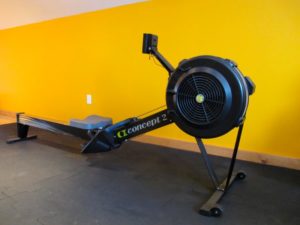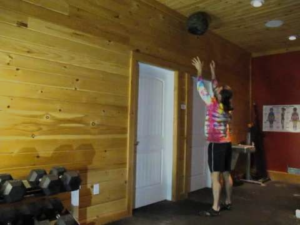February 2016
I. cardio strategies + wall balls

Western view from the Arc Trainer on the ground floor at Beach Hill Fitness.
Hello all,
Welcome to the first of what will hopefully be regular communications from Beach Hill Fitness here in West Glover. In this edition, please find inspiration for a more effective cardio routine – whether you prefer the rower, elliptical, treadmill, ski erg, arc trainer, stationary bike or just running the roads – plus a focus on an exercise, wall balls, that is a total body workout and trains your power and coordination.
If anyone has any questions about anything in this newsletter or any specific exercises or workout plans, please contact me through email or in the gym. Beach Hill Fitness looks forward to helping people get strong, live long, and continuously improve themselves through fitness.
Thanks,
Nate
Be more efficient with cardio. Work in intervals.

This Concept 2 rower, a great total-body cardio option, is on the second floor of the gym.
We all want to keep our fat down and our muscle up, and one of the best ways to do that is to apply a different strategy to what might otherwise be a stagnant cardio routine.
To get more out of the time you spend on aerobic exercise, commonly called cardio, try high-intensity interval training (HIIT). HIIT is not only super efficient in terms of time and cardiovascular gains, but it’s also flexible so that it fits any person’s needs, whether they’ve been exercising for years or are just getting to it now.
HIIT is also the best way to add or at least preserve your muscle mass while burning fat.
What is HIIT? Basically, it’s just a method of exercise in which a person goes back and forth between exerting themselves and taking a rest. The exertion intervals can either be full bore or just some amount of intensity (fully explained below in specific examples), and the intervals for rest can either be stopping the exercise altogether or just taking the effort way down. These intervals can go on either for a prescribed amount of time, or just a certain number of total intervals.
HIIT has become popular in recent years, and for good reason. Studies show that “HIIT significantly enhances VO2 max and O2 pulse and power output in active men and women.” Read more about it here. HIIT workouts can be less than half the time of a moderate-intensity continuous training (MICT) workout (usually measured as working out at 70 to 75% of maximum heart rate), and more effective, too. HIIT is meant to be performed at 85 to 95% of your maximum heart rate (which is roughly 220 minus your age), but should be adjusted to 70 to 85% for beginners.
So how do you work this into your personal routine? Stick to four to 20 minutes of HIIT each time, and shoot for three days a week. Your preferred method is up to you.
Here are just a few examples of HIIT for cardio:
30/20/10 method – Excellent for people of all skill. The object is to give 30% intensity for 30 seconds, 60% intensity for 20 seconds, and 90% intensity for ten seconds, every minute for five minutes then take a one minute break. Repeat this two more times for a total of three rounds that equal 17 minutes (not counting that last minute of a rest interval). I like to use this method as a warm-up on some days and do only one round for five minutes. If you are doing this for the first time, start with one round and see how you feel. Keep track of your distance covered (whether it’s miles walked, or meters rowed) to measure progress over time. How do you know if you are giving 30/60/90%? You don’t, but just make sure to do a low intensity for 30 seconds, medium intensity for 20 seconds, then go all out for ten seconds. This method works best on all the cardio equipment at the gym except the treadmill which would be too slow to change speeds in time. If you want to try this method running, it is best to try it on the road or at a track. Check out this article for more info.
1/1/5 method – A more intermediate method but can be tweaked to meet a person’s skill level. This method is for one minute of your highest sustainable intensity, and one minute of rest, for a total of five rounds that equal nine minutes, not counting the last minute of rest. The goal is to give your highest intensity for one minute and then try to recover for the next minute. This method teaches you how to pace yourself and be consistent. Record your distance covered in the minute and try to be consistent throughout the five intervals. Try and record faster interval times each time you attempt this method. This method works best on all the equipment, from treadmill to elliptical to rower. This method can be altered by increasing/decreasing the work/rest ratio: If you feel you need more rest, take 90 seconds. If you feel a minute is too long to work, start at 30 seconds. In this example, it becomes the 60-second/90-second/5 method or 30/30/5 method. Change the ratio to meet your needs.
Tabata 20/10/8 method – A more advanced method named after sports researcher Dr. Izumi Tabata. This workout takes four minutes to complete. The point is to give maximum effort for 20 seconds and take a ten-second break, for a total of eight rounds. You can add more exercises for a longer workout. For instance, start on the rower and do eight rounds of Tabata, take a one minute break, then move on to the elliptical and do eight rounds of Tabata again. This method would work best with all equipment except the treadmill again as it is too slow for this fast timing. Sprinting outside or on a track would be the best alternative to the treadmill. There is a Tabata timer in the gym and there are also Tabata timer websites for people free of charge. The automatic timer is key to this workout.
As always when you work out, listen to what your body is telling you with each step, rep, or stroke. If your back or knee is feeling weird, stop the exercise, take a break and reevaluate. If you feel ok to go on, try another set but continue to monitor how you feel.
HIIT is a method that can be applied to any workout, whether it’s aerobic conditioning or anaerobic conditioning, like weight training.
Keep in mind, there is no set recipe when it comes to interval training. You can design something that works for you and your current level of fitness to get you to your desired level of fitness. Whether you work and rest at one-minute intervals, or decide you would rather have 30 seconds of both work and rest, or mix it up with a scheme like 30 seconds of work alternated with 20 seconds of rest for each round – you will reap the benefits of HIIT. The point is to just push yourself for a set time, and rest for a set time, over a number of rounds; however you fulfill that goal, as long as you’re challenging yourself, you are training in high-intensity intervals and therefore digging deep with each day of exercise.
The benefits of HIIT include but are not limited to:
- Add/preserve muscle mass while losing fat in less time than with MICT
- Burn way more calories during the 24 hours post-workout vs. with MICT
- Raise natural hormone production more so than with MICT
- Improve vascular function more effectively than MICT
- Significantly increase VO2 max and anaerobic capacity (Tabata’s study compared 60 minutes of MICT versus four minutes of HIIT)
- Save time on cardio to add more time to strength training
Interval training can be for everybody. Each person just needs to adjust the work/rest ratio and choose appropriate levels of intensity.
The timer at Beach Hill Fitness can be set for all the intervals listed above, and more. Ask Nate to walk you through how to use it.
Try this: wall balls
Wall balls are an excellent total body movement that will increase your heart rate quickly upon starting. The object is to get an oversize medicine ball, find a wall (preferably with a target 9-10′ high), and go down into a front squat while holding the ball at chin level, then explode to a standing position while thrusting the ball towards the 9-10′ target. Wait with arms extended for the ball to come down then catch it and go right down into the next front squat if possible. If you are taking too many medicine balls off the chin, then you probably should go down in weight. The goal typically is to string together a bunch of reps, take a quick break, and do some more. This is an athletic exercise which trains compound muscle groups, enabling a person to have more power and coordination under stress.
TRY THIS: Workout I.
This workout is a reps-for-time workout.
30-20-10 reps
- Wall balls 20#
- Push ups
Grab an oversize medicine ball, set your timer and get to work! Do 30 reps of wall balls as quickly as possible then immediately transition to 30 reps of push ups. Next set is 20 reps of each and the final set is ten reps of each. How long of a rest you take between each round of reps is up to you. Stop the timer when you’re finished, and keep track. This workout is difficult because the wall balls quickly raise your heart rate and then performing push ups with an elevated heart rate is strenuous.
You can scale this workout by using less weight on the oversize medicine ball, or substituting air squats for wall balls, and substituting incline push ups for regular push ups.
This workout took me 6:57 to complete. Push ups took me way too long. I’m sure someone out there can better my time. Always feel free to write your time on the white board at the gym!

